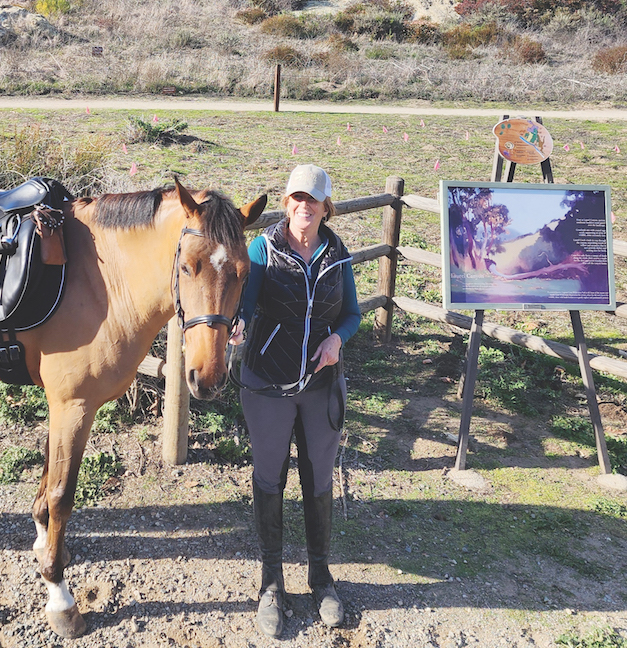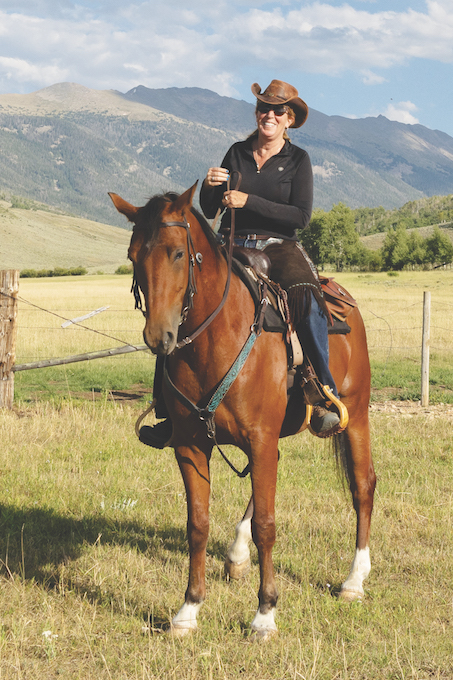
Karin Wyman-Vardaman, the new executive director of Laguna Canyon Foundation, has come full circle, helping to protect the open spaces she grew up enjoying as a child.
By Sharon Stello
A photo of Barbara’s Lake hangs on the wall of Karin Wyman-Vardaman’s office. Next to it is a watercolor painting of the same scene by her mother, recalling special memories of their time together in this peaceful place.
Now, as executive director of Laguna Canyon Foundation since December, Wyman-Vardaman is helping to conserve the same wilderness she enjoyed while growing up in town.
“For me, taking this position … is kind of a way to give back to what gave me so much as a child,” she shares. “I grew up here, graduated from high school here and the canyon was my playground. … We used to ride our horses into town and tie them up at the parking meters to get ice cream and rode our horses to Top of the World and over to the lakes, because there was nothing here. You [could] just cross the road and ride wherever you want[ed].”
Wyman-Vardaman steps into the position after longtime leader Hallie Jones left for a job at Crystal Cove Conservancy in September. Before coming to lead the foundation, Wyman-Vardaman served in the 1980s as director for animal care and operations at Pacific Marine Mammal Center (then known as Friends of the Sea Lions) and senior director of the Ocean Institute in Dana Point for nearly two decades as well as founder and executive director of Working Circle, a nationally recognized nonprofit committed to wolf conservation. She was even named by Forbes magazine as one of 50 women over age 50 making an impact in 2021.
She returned to Orange County in the fall after living in Colorado for about eight years. She resides in San Clemente with her husband, George Vardaman; two dogs, Cainey and Snuggles; and horse, Mikey.
“I love being in the ocean,” she says. “It’s almost a spiritual thing for me to be in the water. It’s one of the reasons I moved back. I love Colorado. It’s so beautiful and it was really convenient for my work, but I just missed the ocean. It’s a soul thing. I had to get back.”
Among her hobbies, Vardaman has enjoyed distance swimming in the ocean and competing in equestrian sports. And she has plenty of plans to increase outreach and education by Laguna Canyon Foundation, which is dedicated to protecting the 22,000-acre South Coast Wilderness, including Laguna Canyon, advocating for open space as well as conducting trailwork and habitat restoration.

Laguna Beach Magazine: What drew you to the Laguna Canyon Foundation position?
Karin Wyman-Vardaman: For me, it wasn’t just taking … another conservation job. It was very deeply meaningful to me. And the … Laguna Canyon Foundation is really special. The expertise and the passion for the land, the plants and the wildlife, protecting it and restoring it, is so deep. … It’s powerful to see the commitment from each and every one of the folks here. Hallie did a great job establishing that culture, and I want to honor that and grow that.
LBM: Any new plans for the foundation?
KWV: One thing I’m really excited about is expanding and developing new education programs for students and adults and also expanding the reach of those programs so more people have the opportunity to remain connected to the land. … The idea is that, through exploration, they discover it on their own … [so] their learning is much deeper versus just interpretation. So I’m really excited to build those out. And then also, expand it so more—students from Title 1 schools have always been our priority, but we also want to make sure that we include other folks that don’t have the opportunity or live in Laguna Beach.
LBM: Are there any challenges the foundation is facing?
KWV: We’re always looking at invasive species. One thing we’ve found is there’s a little bit … of a disconnect in understanding how bad invasive species are. Sometimes people think maybe they’re not invasive anymore because they’ve been here so long. But invasive species will take over and kill native plant species and ruin endangered wildlife habitats. So those have to be mitigated. … You have to be able to control that in order to protect this unique ecosystem that is not found anywhere else in the world. … In order for endangered species—animals—to survive, they need the plants and the soil and everything else to be in balance, from soil health all the way up to the animals. But invasives impact all of that and not in a good way. … Believe it or not, one of the things that people love—I did too—[is wild] mustard. … I didn’t realize how dangerous they are … to the ecosystem.
LBM: Do you have a favorite local trail?
KWV: I love … Aliso and Wood Canyons [Wilderness Park], where I spent a lot of my time. Of course, there was nothing on the hills behind it [when I was a kid]. The first time I went back, it was a little hard because of looking up at all the houses. But having returned again more recently through this position and still seeing the amount of tracks and scat and pictures of wildlife on the trail cameras, I’m like, “OK, this place is still thriving because of this work.” So it really made me feel good. And then I do love Willow [Canyon trail], which is right across from … [the foundation office] and then the lakes because of my childhood memories. They’re all so unique and different. … I love to hike and I do horseback riding. … There’s just something that’s good for the soul once you get out there and see the natural beauty.
